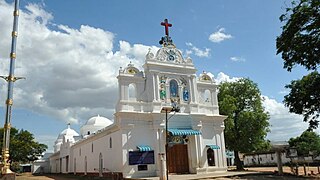
Pudukkottai is the administrative headquarters of Pudukkottai District in the Indian state of Tamil Nadu. It is a town located on the banks of the Vellar River. It has been ruled, at different times, by the mutharaiyar dynasty, Cholas, Early Pandyas, Thondaimans, and the British. It is situated about 395 kilometres (245 mi) southwest of the state capital Chennai and about 55 kilometres (34 mi) southeast of Tiruchirappalli. Tamil Nadu's first woman Asian Games competitor, Santhi Soundarajan, is from Pudukkottai.

Telugu literature is the body of works written in the Telugu language. It consists of poems, short stories, novels, plays, and song lyrics, among others. There is some indication that Telugu literature dates at least to the middle of the first millennium, the first extant works are from the 11th century when the Mahabharata was first translated to Telugu from Sanskrit by Nannaya but there were signs that Telugu literature was already existing. The language has experienced a golden age under the patronage of the Vijayanagara Emperor-Poet Krishnadevaraya.

The Thanjavur Nayakdynasty were the rulers of Thanjavur in the 15th and 17th centuries. The Nayaks, who belonged to the Telugu-speaking Balija social group were originally appointed as provincial governors by the Vijayanagara Emperor in the 15th century, who divided the territory into Nayak kingdoms which were Madurai, Tanjore, Gingee and Kalahasthi. In the mid-15th century they became an independent kingdom, although they continued their alliance with the Vijayanagara Empire. The Thanjavur Nayaks were notable for their patronage of literature and the arts.

Vijayanagara literature was produced in the Vijayanagara Empire during a golden age of literature in South India in general. The rulers patronised Kannada, Telugu, Sanskrit and Tamil scholars who wrote in the Jain, Virashaiva and Vaishnava traditions. The period produced hundreds of works on all aspects of Indian culture, religion, biographies, prabhandas (stories), music, grammar, poetics and medicine. An attempt is made in this section to list the various poets and saints and their most famous works.

Pudukkottai was a kingdom and later a princely state in British India, which existed from 1680 until 1948.
Sriman Hiranyagarbha Ravikula Raja Muthu Vijaya Raghunatha Raja Raghunatha Deva Kilavan Setupati was the first king of Ramnad Kingdom which is also known "Maravar Kingdom". He ruled from 1673 to 1708 and oversaw the growth of the feudal chieftainship of Ramnad into a powerful "Ramnad Kingdom" which is known as "Maravar Kingdom". He rescued the Nayak of Madurai from the tyranny of Rustam Khan and also successfully campaigned against the King of Thanjavur, who later ceded all his territories. It is recorded in the Sethupati copper plates that he belonged to the Surya kulam and Kashyap gothram.

The Thondaimans are chieftains who ruled the region in and around Pudukottai from the 17th to 20th century. The Pudukkottai Thondaiman dynasty was founded by Raghunatha Thondaiman, the brother-in-law of the then Raja of Ramnad, RaghunathaKilavan Setupati. The Pudukottai Samasthanam was under Thondaiman dynasty for one year even after Indian Independence. The Thondaiman dynasty had a special Valari regiment.

The Tondaiman family were Tamil rulers of the ancient Tondai Nadu (Tondaimandalam) division of Tamilakkam in South India. Their capital was at Kanchipuram.
Raja Sri Raghunatha Tondaiman Bahadur was the ruler of the princely state of Pudukkottai from 4 June 1825 to 13 July 1839.
Raja Sri Vijaya Raghunatha Tondaiman Bahadur was the ruler of the pudukottai kingdom from 30 December 1789 to 1 February 1807.
Vijaya Raghunatha Raya Tondaiman may refer to
Raghunatha is a given name. Notable people with the name include:

Periyanayagi Madha Shrine is a Roman Catholic church in the village of Avur, 28 kilometres (17 mi) from the town of Pudukkottai in the Indian state of Tamil Nadu. It was constructed by Rev. John Venatius Bachet in 1547. The church was rebuilt in 1747. The renowned Italian missionary and Tamil scholar Joseph Beschi served in this church.

Raja Sri Brahdamba Dasa Raja Sir Martanda Bhairava Tondaiman was the ruler of the princely state of Pudukkottai from 15 April 1886 to 28 May 1928.
Vijaya Raghunatha Pallavarayar Dorai Raja (1872–1930) was an Indian civil servant and administrator and a member of the royal house of Pudukkottai. He served as the Chief Minister of Pudukkottai state from 1909 to 1922 and regent from 1922 to 1929.
Raja Sri Raya Raghunatha Tondaiman was the ruler of Pudukkottai kingdom from 28 December 1769 to 30 December 1789.
Vijaya Raghunatha Raya Tondaiman I was the second independent ruler of the Pudukkottai kingdom. He reigned from April 1730 to 28 December 1769. His reign was marked with incessant wars with the Thanjavur Maratha kingdom and against the French East India Company and Chanda Sahib.
Raja Sri Raghunatha Raya Tondaiman (1641–1730) was the ruler of the Pudukkottai kingdom from 1686 to 1730. A feudatory chieftain of the Sethupathi of Ramnad, in 1686, Raghunatha Raya Tondaiman was recognised as the independent ruler of Pudukkottai by the Sethupathi for the services he had rendered him.
Raya Rahutta Raya Vajridu Raya Mannida Raya Avadai Raghunatha Tondaiman was a Kallar chieftain of Karambakudi and a feudatory of the Vijayanagar Empire.








